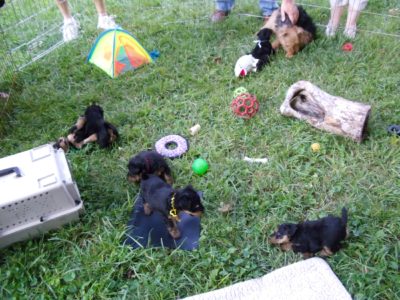The Dog’s Point of View
Sources of Dog’s Point of View
To facilitate communication between you and your dog it is important to be aware of the dog’s point of view. Any dog’s perspective is based on a variety of factors: inherited characteristics, early experiences with mother and littermates, early experiences with other dogs, people, and other animals, and exposure to elements in its environment.
Identifying Dog’s Point of View
Observe your dog’s behavior closely. Watch for small responses as well as more obvious ones. Your dog’s responses will give you information about how open it is to new relationships with people or other dogs. Other responses will tell you whether your dog is calm enough to be available to learn. Listen carefully to your dog’s point of view and respond appropriately to its needs.
Perhaps your dog is eager to learn and ready to develop its relationship with you through clicker training. This type of training supports clear communication, which builds trust and creates a strong bond between the two of you.
Perhaps your dog is fearful or over-excited or in some other way so emotionally involved that it is not available to learn. In that case it will be necessary to help your dog relax and build confidence to the point that it can begin to learn new things. The earlier in a dog’s life we can help a dog achieve a relaxed, confident point of view, the easier it is to do. Some dogs will have great difficulty overcoming early experiences that caused emotional distress.
World View Can Be Influenced from Birth
Dogs bring some of their behavioral tendencies with them at birth. After that they are influenced by their experiences. Their early weeks are influenced mostly by contact with their mother and littermates. Ideally their mother will be calm and attentive to their needs. It is not too early to be handled briefly and gently by people and given Early Neurological Stimulation. Extremes of temperature in the environment can be harmful to puppies.
Influencing a Young Puppy’s World View
Soon after the puppies’ eyes open, they will begin to explore the environment. It is important that they begin now to experience new things daily. Different sights, sounds and smells and surfaces should be introduced regularly so that new things become normal. The puppies may meet more people and other pets in the house who will not harm them.
Social Influence
Puppies benefit socially from being with their mother and their littermates until the age of seven weeks. By that time they will be eating solid food and the mother will have stopped nursing them. The interactions among littermates and the influence of the mother provide valuable lessons that will last a lifetime.
After seven weeks puppies can still benefit from time spent with mother and littermates, but they will be best prepared for life in human society if they begin to spend time on their own. Pups benefit socially at this time from having their own crate or pen and spending time with other dogs only for an hour or so at a time and only under human supervision. If puppy classes are available they should start by 9 or 10 weeks of age. If classes are not available it is important to find other puppies or well-socialized adult dogs with whom they may safely interact. It is very important that they continue to meet a variety of new people, as well.
Educational Influence
At seven weeks puppies have the brain of an adult dog in terms of what they are able to learn. As long as they are kept physically and socially comfortable they can learn many new behaviors. In fact they DO learn new behaviors whether we are teaching them or not, so the best plan is to manage the learning environment so they learn only the things we want them to know, rather than whatever they want. If they have not already had an opportunity to go outside, now is the time to begin – no matter what the weather. They should also practice riding in a car to new (always safe) locations.
Last Chance for Early Influence
Sometime between 12 and 16 weeks a developmental window closes. The pup now has an established world-view. It has made up its mind about how it feels about people, other dogs, and new things in the environment. Ideally it has learned that all of these are fun and interesting and to be welcomed. If its exposure has been limited or if it has experienced a particularly frightening event, the puppy is now old enough that serious remedial work may be necessary to overcome the emotional consequences. From now on, from an emotional point of view, the puppy needs to be treated as an adult with an established point of view.
Changing a Dog’s Point of View
A dog who is over 16 weeks of age has developed its own world-view. It believes what it believes and early experiences cannot be erased. In most cases, however, it is not too late to adjust its point of view. Clicker training can be of significant help in overcoming unwanted emotional consequences. Once the dog understands the association – the clicker means the treat will come – the clicker evokes an emotional response of eager anticipation. The emotion of anticipating the treat can begin to over-ride the feelings created by the original trigger. Repeatedly associating the click and treat with circumstances or event that was the original trigger helps adjust the dog’s point of view. It will begin to look forward to the original trigger because that trigger now predicts a click and a treat.
Clicker Training Affects a Dog’s Point of View in a Beneficial Way:
- It makes communication clear by marking an exact behavior https://www.clickertraining.com/how-to-practice-clicker-mechanics
- It makes learning exciting by engaging the brain’s SEEKING system http://news.cornell.edu/stories/2016/10/jaak-panksepp-lectures-emotions-animals-humans
- It avoids the undesirable effects of punishment https://avsab.org/wp-content/uploads/2019/01/Punishment-Position-Statement_bleeds-10-2018-updated.pdf
- It works with all animals – here is one of my favorite examples: https://www.clickertraining.com/the-butterfly-project







